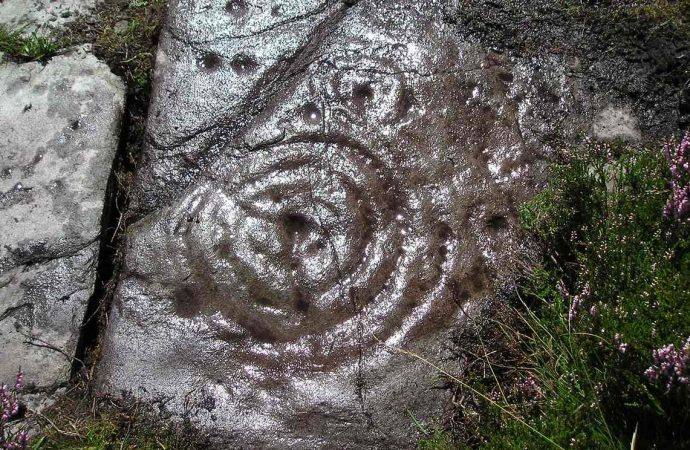Scottish enthusiast George Currie’s prehistoric carvings to be included in ‘exciting’ research project
An amateur archaeologist has tracked down hundreds of prehistoric rock engravings in Scotland in what has been described as a “phenomenal” contribution to the understanding of Britain’s earliest artworks.
Walking in all weathers once or twice a week, George Currie, 66, a musician by trade, has located more than 670 Neolithic and Bronze Age carvings over the past 15 years. He told the Observer: “It was ridiculous … I got tired of recording the stuff. I’ve never come across quite so much.”
There are many more to be found, he believes. Describing the thrill of uncovering ancient artworks that no one has seen for thousands of years, he said: “It’s quite a privilege.”
Currie’s discoveries will be included in the biggest research project into British prehistoric rock art, a five-year, £1m study starting next year. The project will be hosted by Historic Environment Scotland (HES) under the leadership of Dr Tertia Barnett, an honorary fellow of the University of Edinburgh. Rock art is “relatively undervalued and little known”, she said. “This project is very exciting.”
More than 6,000 prehistoric carved rocks are recorded across Britain, of which some 2,500 are in Scotland. Most have patterns based on cup marks – circular depressions in the surface, often surrounded by concentric rings, with lines or grooves that extend from them – and are thought to date from 4000 to 2000BC.
Their original purpose and significance remain a mystery. Among other theories, academics have speculated that they may be territorial markers, fertility symbols, astronomical signs, or simply prehistoric doodles.
The designs and symbols appear to have been shared across Europe, Barnett said. “The cup-and-ring symbol, almost a universal symbol, is found in almost every country – France, northern Spain, Switzerland, northern Italy, Sardinia, Scandinavia. It seems that we were all in contact in pre-EU days, which is a nice thought.” She praises Currie’s solo efforts as a contribution “to scholarship, protection and conservation”.
A semi-retired musician and teacher of guitar, bass and musical theory, Currie used to play with a band, Darts, that had chart success in the 1970s. He lives in Dundee, where he taught in a local college. “The course stopped. I didn’t fully retire, [but] it did give me more time to pursue this.”
Although archaeology was a long-held interest, his devotion to rock art began after he uncovered an unrecorded example two metres from a known site: “I suddenly realised that all these things hadn’t been recorded and hadn’t been discovered … I made a determined effort to find some more.”
He travels regularly to Perthshire, which is particularly fertile terrain. He uses a camera, a compass and GPS to pinpoint sites on “wild, empty moorland, with nothing distinguishable for hundreds of metres”.
Bad weather is no deterrent, he said. “In many respects, winter is the best time because the sun is lower in the sky and the light produces more shadows. That makes it easier to see rock art. It’s possible to look at a surface at midday in summer and you won’t see anything. You look at the same surface at 10am on a winter’s morning and, all of a sudden, you’re seeing something that’s entirely different.”
Some art is concealed by grass or moss, as with his most recent finds this summer. Most are out in the open, he said.
“Caves are few and far between, even in the Scottish hills. It’s always a bit of a puzzle why one [rock] should be chosen over another.
“You might imagine that a smooth surface would be ideal to make an engraving, but very often it’s rough surfaces … Sometimes the markings actually use the contours, cracks and fissures as part of the ornamentation. It’s almost as if the engraver is working with the material and that’s really influencing their decisions.”
The HES research project, with funding from the Arts and Humanities Research Council, will include Edinburgh University, Glasgow School of Art and Kilmartin Museum in Argyll, an area with particularly elaborate rock art.
Barnett said: “This is a really exciting opportunity to revisit rock art that we already know about and potentially to discover new sites and new understandings.”
Source: The Guardian

































Leave a Comment
You must be logged in to post a comment.